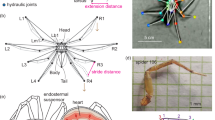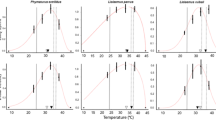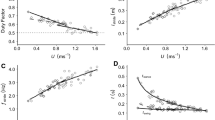Abstract
Great cormorants Phalacrocorax carbo are foot propelled diving birds that seem poorly suited to locomotion on land. They have relatively short legs, which are presumably adapted for the generation of high forces during the power stroke of aquatic locomotion, and walk with a pronounced “clumsy waddle”. We hypothesise (1) that the speed, independent minimum cost of locomotion (C min, ml O2 m−1) will be high for cormorants during treadmill exercise, and (2) that cormorants will have a relatively limited speed range in comparison to more cursorial birds. We measured the rate of oxygen consumption \( (\dot{V}_{{\rm O}_{2}}) \) of cormorants during pedestrian locomotion on a treadmill, and filmed them to determine duty factor (the fraction of stride period that the foot is in contact with the ground), foot contact time (t c), stride frequency (f), swing phase duration and stride length. C min was 2.1-fold higher than that predicted by their body mass and phylogenetic position, but was not significantly different from the C min of runners (Galliformes and Struthioniformes). The extrapolated y-intercept of the relationship between \( \dot{V}_{{\rm O}_{2}} \) and speed was 1.9-fold higher than that predicted by allometry. Again, cormorants were not significantly different from runners. Contrary to our hypothesis, we therefore conclude that cormorants do not have high pedestrian transport costs. Cormorants were observed to use a grounded gait with two double support phases at all speeds measured, and showed an apparent gait transition between 0.17 and 0.25 m s−1. This transition occurs at a Froude number between 0.016 and 0.037, which is lower than the value of ~0.5 observed for many other species. However, despite the use of a limited speed range, and a gait transition at relatively low speed, we conclude that the pedestrian locomotion of these foot propelled diving birds is otherwise generally similar to that of cursorial birds at comparable relative velocities.




Similar content being viewed by others
References
Alexander RM, Jayes AS (1983) A dynamic similarity hypothesis for the gaits of quadrupedal mammals. J Zool 201:135–152
Bamford OS, Maloiy GMO (1980) Energy metabolism and heart rate during treadmill exercise in the Marabou stork. J Appl Physiol 49:491–496
Bartholomew GA, Vleck D, Vleck CM (1981) Instantaneous measurements of oxygen consumption during pre flight warm-up and post flight cooling in sphingid and saturniid moths. J Exp Biol 90:17–32
Baudinette RV, Gill P (1984) The energetics of ‘flying’ and ‘paddling’ in water: locomotion in penguins and ducks. J Comp Physiol B 155:373–380
Baudinette RV, Gill P, O’Driscoll M (1986) Energetics of the little penguin, Eudyptula minor: temperature regulation, the calorigenic effect of food, and molting. Aust J Zool 34:35–46
Bertelli S, Giannini NP (2005) A phylogeny of extant penguins (Aves: Sphenisciformes) combining morphology and mitochondrial sequences. Cladistics 21:209–239
Bevan RM, Woakes AJ, Butler PJ, Boyd IL (1994) The use of heart rate to estimate oxygen consumption of free-ranging black-browed albatrosses Diomedea melanophrys. J Exp Biol 193:119–137
Bevan RM, Woakes AJ, Butler PJ, Croxall JP (1995) Heart rate and oxygen consumption of exercising Gentoo penguins. Physiol Zool 68:855–877
Bullimore SR, Burn JF (2006) Dynamically similar locomotion in horses. J Exp Biol 209:455–465
Christiansen P (2002) Locomotion in terrestrial mammals: the influence of body mass, limb length and bone proportions on speed. Zool J Linn Soc 136:685–714
Cooper CE, Withers PC (2006) Numbats and aardwolves: how low is low? A re-affirmation of the need for statistical rigour in evaluating regression predictions. J Comp Physiol B 176:623–629
Cooper A, Lalueza-Fox C, Anderson S, Rambaut A, Austin J, Ward R (2001) Complete mitochondrial genome sequences of two extinct moas clarify ratite evolution. Nature 409:704–707
Cracraft J, Barker FK, Braun MJ, Harshman J, Dyke G, Feinstein J, Stanley S, Cibois A, Schikler P, Beresford P, García-Moreno J, Sorenson MD, Yuri T, Mindell DP (2004) Phylogenetic relationships among modern birds (Neornithes): toward an avian tree of life. In: Cracraft J, Donoghue MJ (eds) Assembling the tree of life. Oxford University Press, New York
Dimcheff DE, Drovetski SV, Mindell DP (2002) Phylogeny of Tetraoninae and other galliform birds using mitochondrial 12S and ND2 genes. Mol Phylogenet Evol 24:203–215
Donelan JM, Kram R (2000) Exploring dynamic similarity in human running using simulated reduced gravity. J Exp Biol 203:2405–2415
Donne-Gousse C, Laudet V, Hanni C (2002) A molecular phylogeny of Anseriformes based on mitochondrial DNA analysis. Mol Phylogenet Evol 23:339–356
Ellerby DJ, Cleary M, Marsh RL, Buchanan CI (2003) Measurement of maximum oxygen consumption in Guinea fowl Numida meleagris indicates that birds and mammals display a similar diversity of aerobic scopes during running. Physiol Biochem Zool 76:695–703
Fahlman A, Handrich Y, Woakes AJ, Bost CA, Holder R, Duchamp C, Butler PJ (2004) Effect of fasting on the VO2-f(h) relationship in king penguins, Aptenodytes patagonicus. Am J Physiol Regul Integr Comp Physiol 287:R870–R877
Fedak MA, Seeherman HJ (1979) Reappraisal of energetics of locomotion shows identical costs in bipeds and quadrupeds including ostrich and horse. Nature 282:713–716
Fedak MA, Pinshow B, Schmidt-Nielsen K (1974) Energy cost of bipedal running. Am J Physiol 227:1038–1044
Fedak MA, Rome L, Seeherman HJ (1981) One-step N2-dilution technique for calibrating open-circuit measuring systems. J Appl Physiol 51:772–776
Felsenstein J (1985) Phylogenies and the comparative method. Am Nat 125:1–15
Frappell PB, Butler PJ (2004) Minimal metabolic rate, what it is, its usefulness, and its relationship to the evolution of endothermy: a brief synopsis. Physiol Biochem Zool 77:865–868
Froget G, Butler PJ, Handrich Y, Woakes AJ (2001) Heart rate as an indicator of oxygen consumption: influence of body condition in the king penguin. J Exp Biol 204:2133–2144
Garland T Jr, Diaz-Uriarte R (1999) Polytomies and phylogenetically independent contrasts: examination of the bounded degrees of freedom approach. Syst Biol 48:547–558
Garland T Jr, Ives AR (2000) Using the past to predict the present: confidence intervals for regression equations in phylogenetic comparative methods. Am Nat 155:346–364
Garland T Jr, Janis CM (1993) Does metatarsal/femur ratio predict maximal running speed in cursorial mammals? J Zool 229:133–151
Garland T Jr, Harvey PH, Ives AR (1992) Procedures for the analysis of comparative data using phylogenetically independent contrasts. Syst Biol 41:18–32
Garland T Jr, Dickerman AW, Janis CM, Jones JA (1993) Phylogenetic analysis of covariance by computer simulation. Syst Biol 42:265–292
Garland T Jr, Midford PE, Ives AR (1999) An introduction to phylogenetically based statistical methods, with a new method for confidence intervals on ancestral values. Am Zool 39:374–388
Gatesy SM, Biewener AA (1991) Bipedal locomotion: effects of speed, size and limb posture in birds and humans. J Zool 224:127–147
Green JA, Butler PJ, Woakes AJ, Boyd IL, Holder RL (2001) Heart rate and rate of oxygen consumption of expercising macaroni penguins. J Exp Biol 204:673–684
Grémillet D, Chauvin C, Wilson RP, Le Maho Y, Wanless S (2005a) Unusual feather structure allows partial plumage wettability in diving great cormorants. J Avian Biol 36:57–63
Grémillet D, Kuntz G, Woakes AJ, Gilbert C, Robin J-P, Le Maho Y, Butler PJ (2005b) Year-round recordings of behavioural and physiological parameters reveal the survival strategy of a poorly insulated diving endotherm during the Arctic winter. J Exp Biol 208:4231–4241
Griffin TM, Kram R (2000) Penguin waddling is not wasteful. Nature 408:929
Haddrath O, Baker AJ (2001) Complete mitochondrial DNA genome sequences of extinct birds: ratite phylogenetics and the vicariance biogeography hypothesis. Proc R Soc B 268:939–945
Hawkins PAJ, Butler PJ, Woakes AJ, Speakman JR (2000) Estimation of the rate of oxygen consumption of the common eider duck (Somateria mollissima), with some measurements of heart rate during voluntary dives. J Exp Biol 203:2819–2832
Herreid CF, Full RJ (1984) Cockroaches on a treadmill: aerobic running. J Insect Physiol 30:395–403
Hoyt DF, Kenagy GJ (1988) Energy costs of walking and running gaits and their aerobic limits in golden-mantled ground squirrels. Physiol Zool 61:34–40
Hoyt DF, Taylor CR (1981) Gait and the energetics of locomotion in horses. Nature 292:239–240
Johnsgard PA (1993) Cormorants, darters and pelicans of the world. Smithsonian Institution Press, Washington
Kimball RT, Braun EL, Zwartjes PW, Crowe TM, Ligon JD (1999) A molecular phylogeny of the pheasants and partridges suggests that these lineages are not monophyletic. Mol Phylogenet Evol 11:38–54
Kram R, Taylor CR (1990) Energetics of running: a new perspective. Nature 346:265–267
Lachica M, Aguilera JF (2000) Estimation of the energy costs of locomotion in the Iberian pig (Sus mediterraneus). Br J Nutr 83:35–41
Langman VA, Roberts TJ, Black J, Maloiy GMO, Heglund NC, Weber J-M, Kram R, Taylor CR (1995) Moving cheaply: energetics of walking in the African elephant. J Exp Biol 198:629–632
Livezey BC, Zusi RL (2007) Higher-order phylogeny of modern birds (Theropoda, Aves: Neornithes) based on comparative anatomy. II. Analysis and discussion. Zool J Linn Soc 149:1–95
Maddison WP, Maddison DR (2004) Mesquite: a modular system for evolutionary analysis. Version 1.05. http://mesquiteproject.org
Margaria R, Cerretelli P, Aghemo P, Sassi G (1963) Energy cost of running. J Appl Physiol 18:367–370
Marsh RL, Ellerby DJ, Carr JA, Henry HT, Buchanan CI (2004) Partitioning the energetics of walking and running: swinging the limbs is expensive. Science 303:80–83
McNab BK (1997) On the utility of uniformity in the definition of basal rate of metabolism. Physiol Zool 70:718–720
Midford PE, Garland T, Jr, Maddison W (2005) PDAP Package for Mesquite. Version 1.07(1).
Nolet BA, Butler PJ, Masman D, Woakes AJ (1992) Estimation of daily energy expenditure from heart rate and doubly labelled water in exercising geese. Physiol Zool 65:1188–1216
Pagel MD (1992) A method for the analysis of comparative data. J Theor Biol 156:431–442
Pinshow B, Fedak MA, Schmidt-Nielsen K (1977) Terrestrial locomotion in penguins: it costs more to waddle. Science 195:592–594
Purvis A, Garland T Jr (1993) Polytomies in comparative analyses of continuous characters. Syst Biol 42:569–575
Randi E (1996) A mitochondrial cytochrome B phylogeny of the Alectoris partridges. Mol Phylogenet Evol 6:214–227
Roberts TJ, Kram R, Weyand PG, Taylor CR (1998) Energetics of bipedal running I. Metabolic cost of generating force. J Exp Biol 201:2745–2751
Rubenson J, Heliams DB, Lloyd DG, Fournier PA (2004) Gait selection in the ostrich: mechanical and metabolic characteristics of walking and running with and without an aerial phase. Proc R Soc Lond B 271:1091–1099
Schmidt-Nielsen K (1972) Locomotion: energy cost of swimming, flying and running. Science 172:222–228
Schmidt-Nielsen K (1997) Animal physiology: adaptation and environment. Cambridge University Press, Cambridge
Seymour RS, Withers PC, Weathers WW (1998) Energetics of burrowing, running, and free-living in the Namib desert golden mole (Eremitalpa namibensis). J Zool 244:107–117
Taylor CR, Schmidt-Nielsen K, Raab JL (1970) Scaling of energetic cost of running to body size in mammals. Am J Physiol 219:1104–1107
Taylor CR, Heglund NC, Maloiy GMO (1982) Energetics and mechanics of terrestrial locomotion: I. Metabolic energy consumption as a function of speed and body size in birds and mammals. J Exp Biol 97:1–22
Vaillancourt E, Prud’Homme S, Haman F, Guglielmo CG, Weber J-M (2005) Energetics of a long-distance migrant shorebird (Philomachus pugnax) during cold exposure and running. J Exp Biol 208:317–325
Williams TM (1983) Locomotion in the North American mink, a semi-aquatic mammal II. The effect of an elongate body on running energetics and gait patterns. J Exp Biol 105:283–295
Wilson RP, White CR, Quintana F, Halsey LG, Liebsch N, Martin GR, Butler PJ (2006) Moving towards acceleration for estimates of activity-specific metabolic rate in free-living animals: the case of the cormorant. J Anim Ecol 75:1081–1090
Withers PC (2001) Design, calibration and calculation for flow-through respirometry systems. Aust J Zool 49:445–461
Acknowledgments
We thank Lewis Halsey, Alex Kabat, and Susannah Thorpe for many helpful discussions, and two anonymous referees for their constructive comments. This research was supported by Natural Environment Research Council Grant NER/A/2003/00542 to G.R.M., P.J.B. and A. J. Woakes. All experiments were conducted under licence in accordance with the Animals (Scientific Procedures) Act 1986.
Author information
Authors and Affiliations
Corresponding author
Additional information
Communicated by I.D. Hume.
Rights and permissions
About this article
Cite this article
White, C.R., Martin, G.R. & Butler, P.J. Pedestrian locomotion energetics and gait characteristics of a diving bird, the great cormorant, Phalacrocorax carbo . J Comp Physiol B 178, 745–754 (2008). https://doi.org/10.1007/s00360-008-0265-9
Received:
Revised:
Accepted:
Published:
Issue Date:
DOI: https://doi.org/10.1007/s00360-008-0265-9




